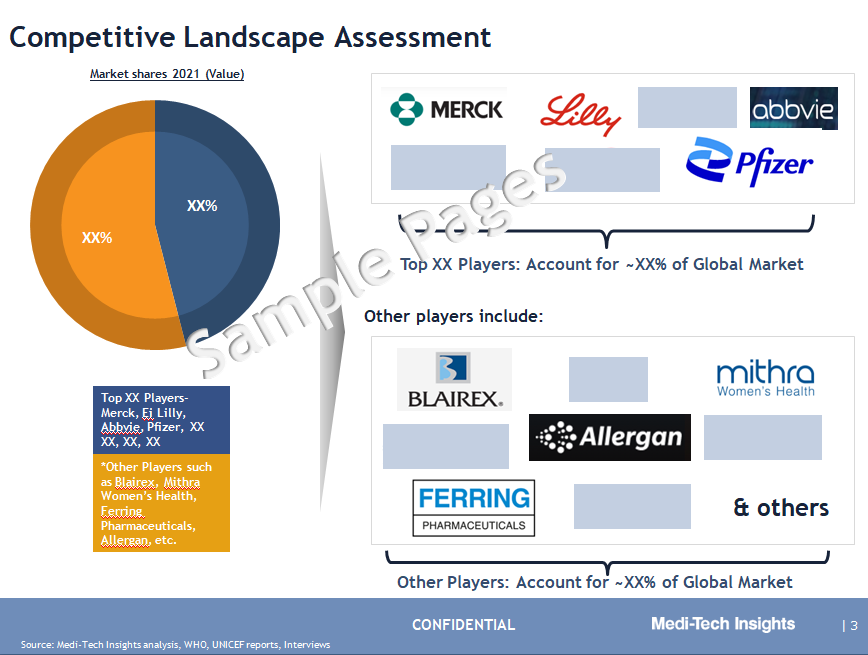
Women’s Health Market Report 2026 – A Booming Multi-billion Dollar Industry

The global Women’s Health Market was valued at $38 billion in 2021 and is expected to grow at a CAGR of over 4.5% to cross $47 billion by 2026, driven by the growing number of women-centric diseases (such as anemia, endometriosis, osteoporosis, breast cancer, menopause), the introduction of innovative new products for women’s health, favourable government initiatives to curb population growth, and growing demand for contraceptives to avoid unwanted pregnancies.
One-half of the world’s population is women and they account for ~80% of consumer purchasing decisions in the healthcare industry. Women’s Health is a branch of medicine that focuses on the prevention and diagnosis of diseases that affect a woman’s physical and emotional well-being. It encompasses a broad variety of treatments, drugs, and surgical products for diseases related to women.
Emerging Opportunities in Women’s Health Market
The rising prevalence of infectious and chronic diseases amongst a large group of the female population is a key factor driving the women’s health market. There is great potential to begin addressing these conditions in new ways. Recent advances in genomics, tissue engineering, artificial intelligence, and cell and gene therapy have synergized a new wave of healthcare innovations that can be applied to create products and solutions specific to women's conditions.
For example, researchers are studying transcriptomics (the study of RNA molecules in a cell) for treating elusive conditions such as preeclampsia or preterm birth. On the other hand, tissue engineering is being used to create uterine organoids to push the knowledge frontier on endometriosis. Genomics is another research area that can help researchers in realizing the potential of personalized medicine. There has been extraordinary growth in terms of technology from predictive AI solutions to modeling unique DNA profiles which uses machine learning algorithms to analyze user data to provide unique, actionable insights and treatment plans related to symptom progression. A favorable environment for research activities is expected to further drive growth opportunities in this market.
“Women’s health is not a niche market, it includes much more than just maternal or reproductive care. Indeed, women’s healthcare presents enormous opportunities for value creation and for improving the lives and livelihoods of women, with positive effects that redound across society.” -Executive Vice President, Global Operations and Supply Chain, Women’s Health Company, United States
Key Market Trends: Women’s Health Market
The women’s health market is a quite steady but competitive market marked by the presence of both established and new players. Players operating in the market adopt both organic and inorganic growth strategies such as collaborations and acquisitions to garner market share. For instance,
- In March 2022, Carlyle Group Inc. and PAI Partners announced the acquisitions of women’s health business Theramex from private equity firm CVC Capital Partners.
- In November 2021, Organon announced the acquisition of Forendo Pharma, a clinical-stage drug development company focused on novel treatments for women’s health.
- In May 2021, Probi announced a collaboration with Tervisetehnoloogiate Arenduskeskus by signing a long-term research and development collaboration agreement aimed to develop novel products based on probiotic lactobacilli strains focused on vaginal health.
- In May 2021, Partners Group announced the acquisition of Axia Women’s Health, a leading women’s healthcare provider in the US.
- In December 2020, Pfizer, Inc. collaborated with Myovant Sciences for the commercialization and development of Relugolix which is the first and only oral GnRH antagonist for oncology and women’s health.
- In September 2020, Bayer expanded its woman's healthcare product portfolio with the acquisition of KaNDy Therapeutics Ltd.
Other players such as Novartis AG, Abbvie, Amgen, and J&J are also continuously engaging in the development of novel drugs for women’s health and also expanding their distribution channels across the globe to establish their footprint in emerging markets. Private equity firms are also making investments in potentially high-growth areas/companies in this space, Ex. Mithra (Goldman Sachs International, 2022), SteelSky Ventures raises the largest women's health VC fund (2022). These inorganic developments such as acquisitions, collaborations, and investments are expected to drive the women’s health market in the forecasted period.
Key Challenges/ Constraints : Women’s Health Market
The high cost associated with clinical care in some countries and side effects associated with the usage of few women's health drugs ( such as night sweats, headache, nausea, difficulty sleeping, absence of periods, anxiety, joint pain, depression, and mood changes) is likely to restrain the growth of the women’s health market.
North America: The Largest Women’s Health Market
North America has the largest women’s health market, followed by Europe and APAC. The large share of North America can be attributed to the strong economies of the US and Canada, established reimbursement policies, early approval & commercialization of products, increased awareness regarding maintaining good health, supportive government regulations, and the presence of key market players in this region. APAC holds a minor share in the global market, however, APAC is expected to witness strong growth in the coming years, due to growing awareness about the importance of women’s health and wellbeing.
Competitive Landscape Analysis: Women’s Health Market
Some of the key players operating in the global women's health market are AbbVie Inc, Agile Therapeutics, Amgen Inc., Eli Lilly & Company, Pfizer Inc., Merck & Co., Organon, Theramex, Ferring Pharmaceuticals, Mylan N.V., Blairex Laboratories, Apothecus Pharmaceutical, Johnson & Johnson, LUPIN, Bayer AG, AstraZeneca, Novartis AG, Mithra Pharmaceuticals, Allergan, among others.
The growth prospects of the market look promising given strategic collaborations & acquisitions, favorable regulatory landscape, and rise in investments from private equity, venture capitalists, and government globally, new product launches, and advances in R&D to build a robust product pipeline by players.
Key Strategic Questions Addressed
- What is the market size & forecast of the Women’s Health market?
- What are the historical, present, and forecasted market shares and growth rates of various segments and sub-segments of the Women’s Health market?
- How has Covid impacted the Women’s Health market?
- What are the major growth drivers, restraints/challenges impacting the market?
- What are the opportunities prevailing in the Women’s Health market?
- How is the investment landscape?
- Which region has the highest share in the global market? Which region is expected to witness the highest growth rate in the next 5 years?
- Who are the major players operating in the market? How is the competitive positioning of key players?
- Who are the new players entering the Women’s Health market?
- What are the key strategies adopted by players?
The study has been compiled based on the extensive primary and secondary research.
Secondary Research (Indicative List)

Primary Research
To validate research findings (market size & forecasts, market segmentation, market dynamics, competitive landscape, key industry trends, etc.), extensive primary interviews were conducted with both supply and demand side stakeholders.
Supply Side Stakeholders:
- Senior Management Level: CEOs, Presidents, Vice-Presidents, Directors, Chief Technology Officers, Chief Commercial Officers
- Mid-Management Level: Product Managers, Sales Managers, Brand Managers, R&D Managers, Business Development Managers, Consultants
Demand Side Stakeholders:
- Stakeholders in Hospitals & Clinics, Obstetrics & Gynecology Centers, Ambulatory Surgical Centers, Research Institutes, and Other End Users.
Breakdown of Primary Interviews

Market Size Estimation
Both ‘Top-Down and Bottom-Up Approaches’ were used to derive market size estimates and forecasts.
Data Triangulation
Research findings derived through secondary sources & internal analysis was validated with Primary Interviews, Internal Knowledge Repository and Company’s Sales Data.



